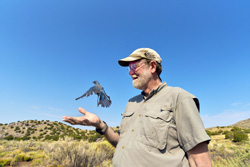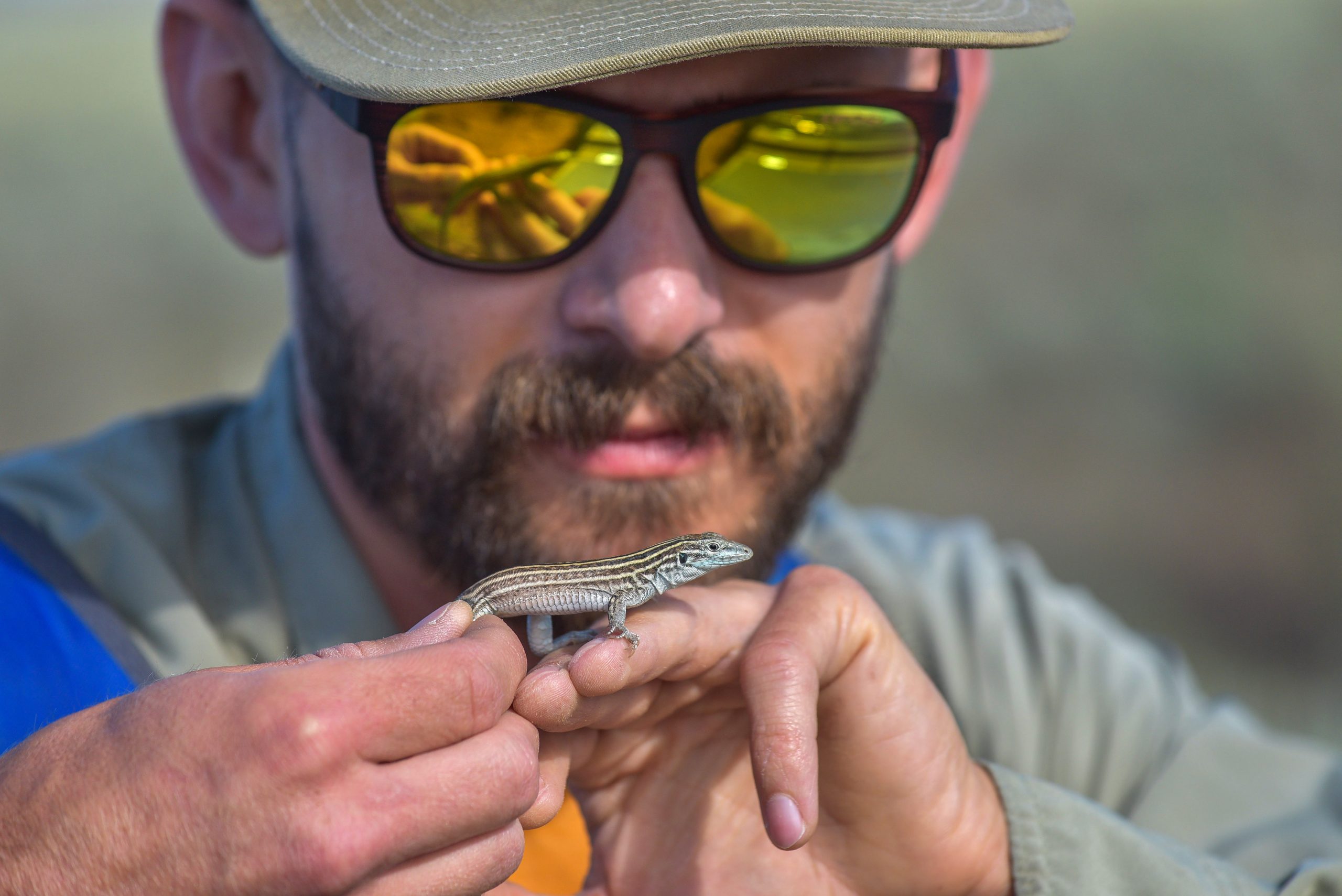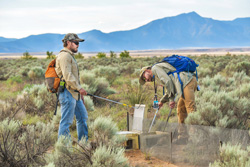ALBUQUERQUE, N.M. — Its heart beating rapidly, a wild gray flycatcher sits in the palm of a steady hand, making side-eye contact and shaking, waiting for just the right moment to escape from its perceived human predator.
Mere seconds are filled with fear, connection and protection, and the moment is over the instant the bird spreads its wings and musters enough courage to soar swiftly into the open space at Sandia National Laboratories, its home until it migrates south.

For half a dozen Sandia biologists in the Ecology Program, wildlife catch-and-release is what they look forward to most at “the office.” They work with birds, look for reptiles and monitor other wildlife around the labs.
They regularly spend their days in the field tracking species on lands controlled by the Department of Energy, respond to animal calls in and around buildings, conduct species inventories on specific animals, set up cameras to watch owls and nests and study vegetation.
Some days in the field — particularly shifts spent with birds — begin well before sunrise in a parking lot where the team gathers their gear and jumps in dusty trucks, flipping on headlights and driving 20 minutes southeast on Kirtland Air Force Base in the dark. When they reach the Manzano Mountain foothills, they set up nets and capture birds and collect data for six hours.
On the days they work with reptiles, biologists venture into the field a little later, and wildlife rescue calls can come at any time during the workday.
Natural, human variables involved when trying to determine trends
Bird data collected by Sandia biologists shows a combination of positive and negative trends depending on the species and habitats they use, and several variables are involved, said wildlife biologist Steve Cox.
A couple of species that show positive trends include the western kingbird and black-throated gray warbler, Cox said.
Three species that show a negative trend include the scaled quail, northern mockingbird and mourning dove, possibly due to drought, floods or human land use, Cox said. Biologists don’t necessarily know the cause of trends with small datasets over a few years.
“These are just examples,” said Cox. “We have encountered well over 100 species of birds while conducting various surveys. For some species, we just don’t have enough data to interpret any kind of trending analysis. With some species the annual variation is such that we can’t determine if there is positive, negative or stable trend.”
Sandia biologists track gray vireos for first time
This year, biologists hoped to recapture some of the 13 gray vireos they banded and outfitted with tiny geolocators last year. Sandia wildlife biologist Matthew Baumann came up with the idea. The gray vireo is listed as a species of concern in the state, and the geolocators could provide more information about them and where they migrate and spend the winter months. Gray vireos had never been tracked with geolocators, and Kirtland Air Force Base happens to have one of the highest populations of the species in New Mexico.

Recording the time and angle of the sun, geolocators roughly track where the birds have been. This year, Sandia biologists recaptured four of the 13.
“It’s pretty remarkable given that previous research on other species has shown that sometimes you only get one back,” Baumann said, adding it’s possible they could capture more next year.
Baumann said preliminary analysis suggests the gray vireos living on the base spend winters in Baja and Southern Sonora, Mexico.
The team is also part of a North American avian program called Monitoring Avian Productivity and Survivorship established in 1989. More than 1,200 MAPS monitoring stations are located across the country and Canada with participating biologists providing data that gives insight on avian population, breeding, the effects of weather, climate and habitat loss.
Using mist nets about 36 feet in length and 8 feet in height, Sandia biologists capture birds and collect information on age, sex and body condition, and place a band, or a tiny metal ring, around one of their legs. Each band has a number on it so that no two birds are numbered the same. This provides data about where and when the bird was first banded to biologists who might catch it later.
Cox said the nets only capture a small percentage of the birds in the area due to their relatively short measurements.
“We’re not sampling anything above these nets. Some people will say, you’re only catching a tenth of 1 percent. Yeah, but that’s measurable.”
Biologists evaluate lizards, snakes, for long-term data analysis
It’s not every day biologists come across rattlesnakes at Sandia, but when they do, the slithering doesn’t make them squirm.
In the summer, the biologists check traps twice a day Monday through Thursday in two locations on Sandia property, hoping to find lizards, snakes and frogs. They might also catch beetles, or black, eight-legged arachnids. Only reptiles and amphibians will be evaluated, and everything that creeps, crawls, hops and slithers will be set free. During the winter, data is analyzed.
“We can start keying in on things like reproductive timing and development,” said wildlife biologist Evan Fahy. “That’s important when looking at long-term data sets. We look at whether or not those very important lifecycle events are shifting.”
Ecology team educates workforce on laws, conservation

As a DOE laboratory, Sandia biologists help the workforce follow local and federal laws regarding wildlife and vegetation, said Cox.
“Ecology is a really important science, so it’s great that Sandia supports what we do,” said wildlife biologist Callan Pope.
According to the Migratory Bird Treaty Act, it is illegal for a person to capture, handle, put at risk, kill or maim birds that are indigenous to North America. This can temporarily hold work at Sandia when birds or nests are discovered in technical and experimental areas.
When this happens, Cox tries to find something staff can connect with to help educate them. For some people, it’s local and federal laws; for others, it may be safety. Sometimes they can connect with the wildlife itself, and occasionally the biologists even change someone’s mind or open a window of curiosity for that person into wildlife.
“Wildlife is often the common language between us and a physicist,” said Fahy. “It’s always very interesting to hear people’s experiences with wildlife.”